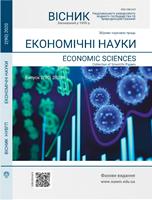JUSTIFICATION OF QUANTITATIVE AND QUALITATIVE ASSESSMENT OF ANTI-CRISIS STABILITY OF ENTERPRISE
DOI:
https://doi.org/10.31713/ve2202010Keywords:
anti-crisis stability, evaluation of crisis anti-crisis enterprise stability, balanced scorecard, integral indicator, anti-crisis stability level, anticrisis enterprise strategy.Abstract
The enterprise, like any economic system, operates in conditions ofpermanent changes in the external economic environment and internalpotential, which violate its equilibrium. For the company as a market player, its is vital to return to a state of economic equilibrium after the effects of negative crisis effects. The lack of timely response of the enterprise and proper management influence leads to the fact that the symptoms of a crisis situation can become a serious threat to its further functioning. These arguments prove the need for preventive anti-crisis management. That is why the issues of assessment and identification of anti-crisis stability of the enterprise become especially relevant.The article reveals the essential characteristics of the anti-crisisstability of the enterprise. A critical analysis of methods for assessing thecrisis resilience of the enterprise. An algorithm of comprehensivesubstatiation of parameters for assessing the anti-crisis stability of theenterprise on the basis of a balanced scorecard. In the context of fourprojections (finance, clients, internal business processes, training anddevelopment of staff), a system of functional components and corresponding indicators of anti-crisis stability of the enterprise are proposed. Using analytical procedures, a quantitative assessment of the level of anti-crisis stability of the enterprise by the integral indicator was made. In the process of qualitative evaluation, a map was developed to assess the crisis resistance of the enterprise, which allowed to identify its type and correspondence to the stage of the crisis process. Based on the results of calculations, a system of strategic goals and measures (initiatives) to increase the anti-crisis resilience of the enterprise is proposed. The projected estimation of change of anti-crisis stability of the investigated enterprise is carried out.References
Dzhereliuk Yu. O. Otsiniuvannia vnutrishnoi antykryzovoi stiikosti turystychnoho pidpryiemstva. Hlobalni ta natsionalni problemy ekonomiky. 2018. Vyp. 21. URL: http://global-national.in.ua/issue-21-2018 (data zvernennia: 25.06.2020).
Kaplan Robert S., Norton Deivyd P. Sbalansyrovannaia systema pokazatelei. Ot stratehyy k deistvyiu / per. s anhl. 2-e yzd., yspr. y dop. M. : Olymp-Byznes, 2004. 320 s.
Kyzym M. O., Pylypenko A. A., Zinchenko V. A. Zbalansovana systema pokaznykiv : monohrafiia. Kh. : VD «INZhEK», 2007. 192 s.
Kostina O. M. Systema pokaznykiv dlia otsinky antykryzovoi stiikosti promyslovoho pidpryiemstva. URL: http://repository.hneu.edu.ua>bitstream (data zvernennia: 25.06.2020).
Kostrychenko V. M., Kovalchuk V. O. Otsiniuvannia antykryzovoi stiikosti pidpryiemstva: metodychni aspekty. Vcheni zapysky Tavriiskoho natsionalnoho universytetu imeni V.I. Vernadskoho. Ser. Ekonomika i upravlinnia. 2019. Tom 30 (69). N 5. Ch. 2. S. 57–63.
Kostrychenko V. M. Antykryzova stiikist pidpryiemstva: otsiniuvannia na zasadakh zbalansovanoi systemy pokaznykiv. Ekonomika i upravlinnia pidpryiemstvamy: teoriia, metodyka, praktyka : kolektyvna monohrafiia / kol. avtoriv. Poltava : PP «Astraia», 2020. 240 s. S. 209–214.
Koiuda V. O., Kostina O. M. Napriamy ta skladovi otsiniuvannia antykryzovoi stiikosti promyslovoho pidpryiemstva. Teoretychni i praktychni aspekty ekonomiky ta intelektualnoi vlasnosti. 2015. Vyp. 2 (12). T. 2. S. 39–47. URL: http://nbuv.gov.ua/UJRN/Tpaeiv_2015_2(2)__8 (data zvernennia: 25.06.2020).
Loktyonov M., Zub A. Teoryia y praktyka antykryzysnoho upravlenyia. M. : Henezys, 2005. 576 s.
Burshtyn Ukrainy : ofitsiinyi sait DP. URL: http://amber-gem.com (data zvernennia: 25.06.2020).
Piletska S. T. Metodolohiia antykryzovoho upravlinnia ekonomichnoiu stiikistiu aviapidpryiemstv : dys. … d-ra ekon. nauk : 08.00.04. Kyiv, 2014. 791 s.
Rogova V. A. Kontseptsiya i etapyi upravleniya antikrizisnoy ustoychivostyu organizatsiy. Vestnik YURGTU (NPI). 2012. № 1. C. 51–55.
Svoboda T. I. Teoretychni peredumovy formuvannia antykryzovoi stratehii torhovelnoho pidpryiemstva. Ekonomichna stratehiia i perspektyvy rozvytku sfery torhivli ta posluh. 2009. Vyp. 2. S. 322–329. URL: http://nbuv.gov.ua/UJRN/esprstp_2009_2_48 (data zvernennia: 25.06.2020).
Uryivskaya L. V. Povyishenie antikrizisnoy ustoychivosti selskohozyaystvennyih predpriyatiy v sisteme gosudarstvennogo regulirovaniya APK : avtoref. dis. … kand. ekon. nauk : 08.00.05. M., 2010. 20 s.
Harrington J. The desirability function. Industrial Quality Control. 1965. No 21(10). P. 494–498.
Kostrychenko V., Kravtsiv M. Methodical imperatives in estimating of economic stability of the enterprise. International Journal of New Economics, Public Administration and Law. Varna-Świnoujście, 2018. № 1 (1). P. 101–111.

